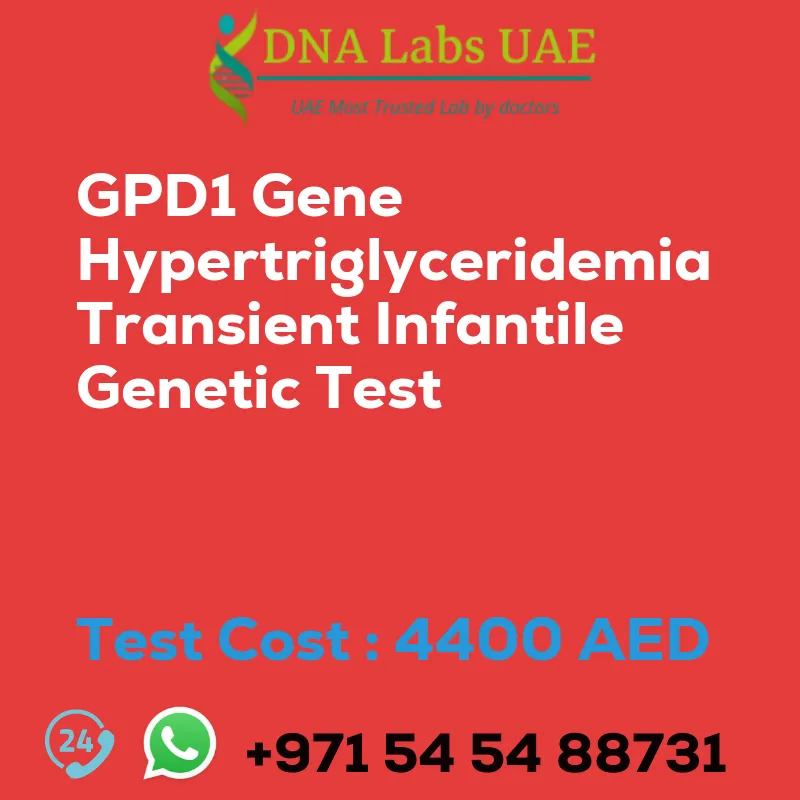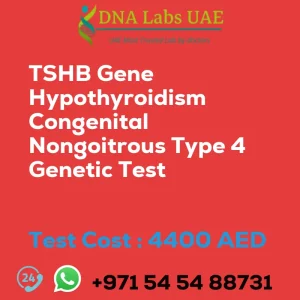GPD1 Gene Hypertriglyceridemia Transient Infantile Genetic Test
Test Name: GPD1 Gene Hypertriglyceridemia Transient Infantile Genetic Test
Components: Blood or Extracted DNA or One drop Blood on FTA Card
Price: 4400.0 AED
Sample Condition: Blood or Extracted DNA or One drop Blood on FTA Card
Report Delivery: 3 to 4 Weeks
Method: NGS Technology
Test Type: Hepatology, Nephrology, Endocrinology Disorders
Doctor: General Physician
Test Department: Genetics
Pre Test Information: Clinical History of Patient who is going for GPD1 Gene Hypertriglyceridemia, Transient Infantile NGS Genetic DNA Test. A Genetic Counselling session to draw a pedigree chart of family members affected with GPD1 Gene Hypertriglyceridemia, Transient Infantile NGS Genetic DNA Test gene GPD1
Test Details: GPD1 gene hypertriglyceridemia is a genetic disorder characterized by high levels of triglycerides in the blood. It is caused by mutations in the GPD1 gene, which provides instructions for making an enzyme called glycerol-3-phosphate dehydrogenase. Glycerol-3-phosphate dehydrogenase is involved in the breakdown of fats in the body. Mutations in the GPD1 gene can lead to a deficiency or dysfunction of this enzyme, resulting in the accumulation of triglycerides in the blood. A next-generation sequencing (NGS) genetic test can be used to detect mutations in the GPD1 gene. NGS is a high-throughput sequencing technology that allows for the simultaneous analysis of multiple genes or the entire genome. It can provide comprehensive genetic information and help identify specific mutations that may be causing hypertriglyceridemia. Transient infantile hypertriglyceridemia refers to a temporary increase in triglyceride levels during infancy. It is often associated with certain medical conditions or dietary factors and typically resolves on its own as the child grows older. NGS genetic testing for GPD1 gene hypertriglyceridemia can help in the diagnosis and management of the condition. It can provide valuable information about the specific genetic mutations present, which can guide treatment decisions and help predict the long-term outlook for affected individuals.
| Test Name | GPD1 Gene Hypertriglyceridemia transient infantile Genetic Test |
|---|---|
| Components | |
| Price | 4400.0 AED |
| Sample Condition | Blood or Extracted DNA or One drop Blood on FTA Card |
| Report Delivery | 3 to 4 Weeks |
| Method | NGS Technology |
| Test type | Hepatology Nephrology Endocrinology Disorders |
| Doctor | General Physician |
| Test Department: | Genetics |
| Pre Test Information | Clinical History of Patient who is going for GPD1 Gene Hypertriglyceridemia, transient infantile NGS Genetic DNA Test. A Genetic Counselling session to draw a pedigree chart of family members affected with GPD1 Gene Hypertriglyceridemia, transient infantile NGS Genetic DNA Test gene GPD1 |
| Test Details |
GPD1 gene hypertriglyceridemia is a genetic disorder characterized by high levels of triglycerides in the blood. It is caused by mutations in the GPD1 gene, which provides instructions for making an enzyme called glycerol-3-phosphate dehydrogenase. Glycerol-3-phosphate dehydrogenase is involved in the breakdown of fats in the body. Mutations in the GPD1 gene can lead to a deficiency or dysfunction of this enzyme, resulting in the accumulation of triglycerides in the blood. A next-generation sequencing (NGS) genetic test can be used to detect mutations in the GPD1 gene. NGS is a high-throughput sequencing technology that allows for the simultaneous analysis of multiple genes or the entire genome. It can provide comprehensive genetic information and help identify specific mutations that may be causing hypertriglyceridemia. Transient infantile hypertriglyceridemia refers to a temporary increase in triglyceride levels during infancy. It is often associated with certain medical conditions or dietary factors and typically resolves on its own as the child grows older. NGS genetic testing for GPD1 gene hypertriglyceridemia can help in the diagnosis and management of the condition. It can provide valuable information about the specific genetic mutations present, which can guide treatment decisions and help predict the long-term outlook for affected individuals. |








